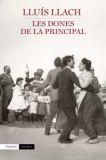New Spanish Books: The online guide of titles from Spanish publishers and literary agents with rights for translation in the UK. To consult titles available in other markets please click on the above links.
Les dones de la Principal

Maria Roderich (The Old Lady), Maria Magí (The Mrs) and Maria Costa are three women who, throughout almost a century, have run La Principal, the most important house in the village of Pous, in the heart of the grape-producing region of La Abadia. Those three, grandmother, daughter, have made the vines flourish due to a series of transformations that have kept the business going. But there is a dark secret in the history of La Principal: the murder, on 18th July 1936, of the man who had been their overseer. After the war, a police inspector decides to solve the case and opens an investigation that will lead him to discover the secrets of the family and a web of knotted temperaments, passions and power.
Les Dones de la Principal is the second novel by musician turned novelist Lluis Llach, whose first novel was published to considerable success in 2012, a success which has been subsequently repeated with his second. It is part historical novel, part detective novel and part love story and it never fails to engage the reader, keeping them constantly surprised with a succession of twists and turns which occur as the story progresses.
The novel tells the story of three generations of women, all called Maria, all who run the house and wine producing estate, la Principal, which is the largest and most noted in the village of Pous in the wine-producing area of Abadia. (…)
(…) the originality of the novel lies in the way it is told. Underlying the story of the family is the story of a crime; the murder of a former foreman of the estate whose body is left in a sack on the doorstep of the house (…)
This is a brilliantly engaging and original novel. (…)The three women are formidably portrayed, and there are some scenes, such as when Maria Magi is carried on her “throne” through the streets to mass by her workers, which are so vivid that the whole novel comes alive(…) The inspector is also a fascinating character (…)
In terms of its translatability, “Les Dones de la Principal” would be an excellent choice because of the strength of plot and character. It is structured in such a way that the end of every chapter leaves the reader wanting to read on and even when, after two thirds of the way through, it appears that the case has been wrapped up, there are still more surprises to come. (…) with the current trend for detective novels as strong as ever, the nod to the more traditional of these in this novel make it an ideal candidate for translation into English.
From the reader´s report by Jennifer Arnold
